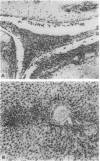Abstract
Although the cause (or causes) of rheumatoid arthritis is unknown, many workers have suggested that microorganisms play a part. The intestinal flora in particular has been related to the development of joint inflammation. It has been shown previously that cell wall fragments of several anaerobic Gram positive intestinal bacteria of human origin are arthritogenic after a single intraperitoneal injection in Lewis rats. The part played by indigenous microflora in this model has now been studied by decontaminating Lewis rats before the injection of Eubacterium aerofaciens cell wall fragments. The pattern and severity of arthritis appeared to be comparable in decontaminated and control rats. The second goal of this work was to isolate arthritogenic bacteria from the autochthonous intestinal flora of rats. Only a limited number of bacteria showing a resemblance to arthritogenic strains from human intestinal flora (i.e. E aerofaciens and Bifidobacterium adolescentis) could be isolated. These strains did not induce chronic arthritis after intraperitoneal injection. This may explain why spontaneous arthritis did not develop in Lewis rats.
Full text
PDF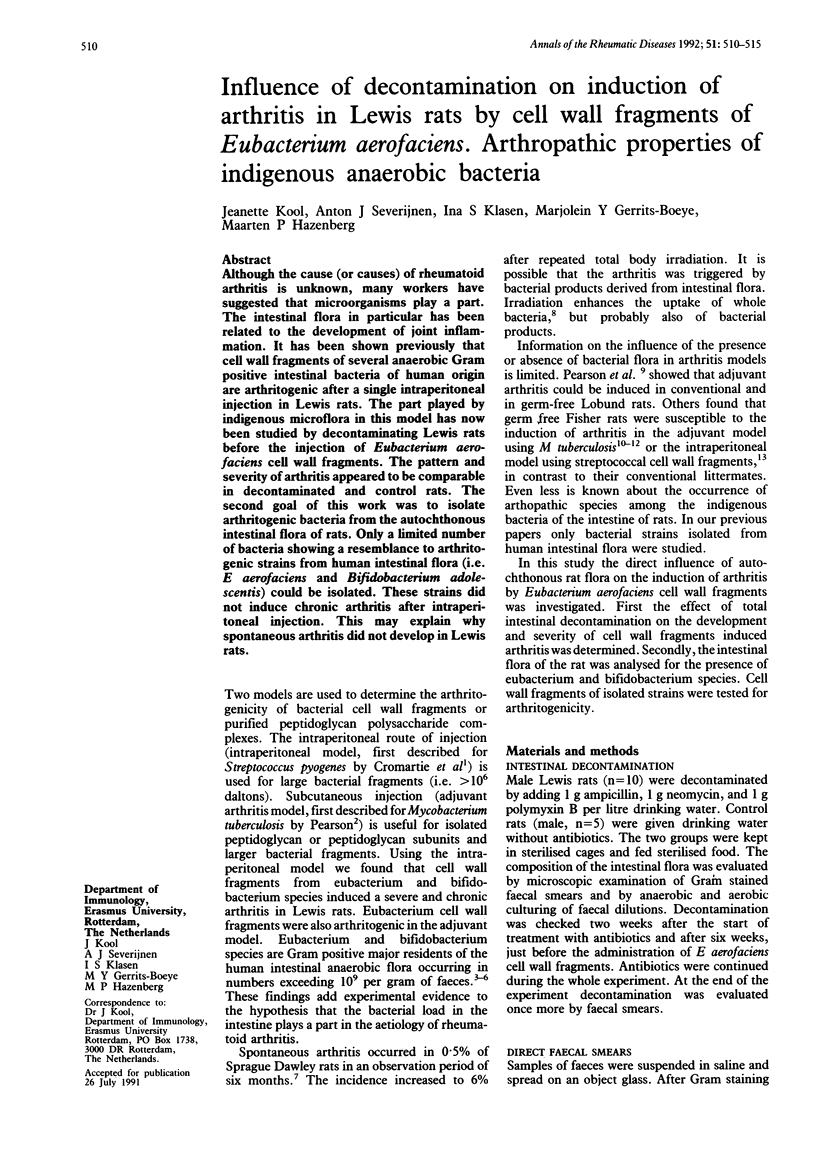
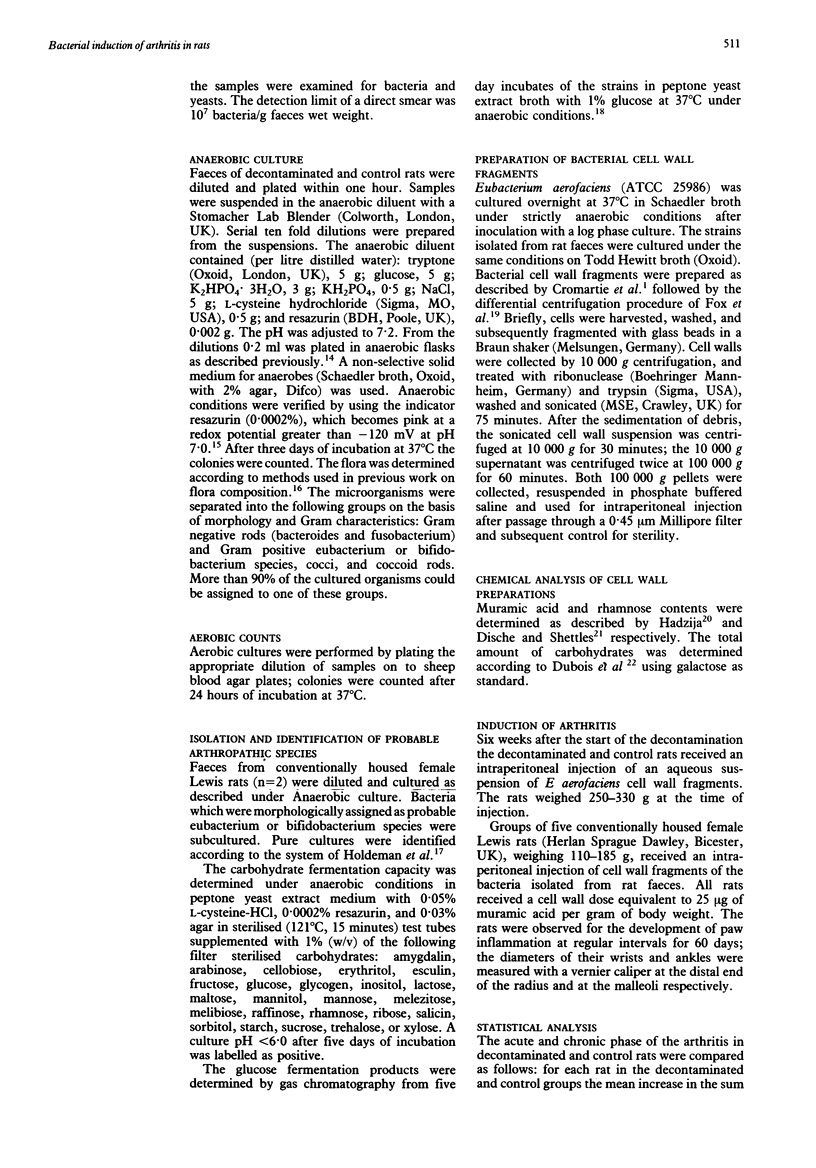
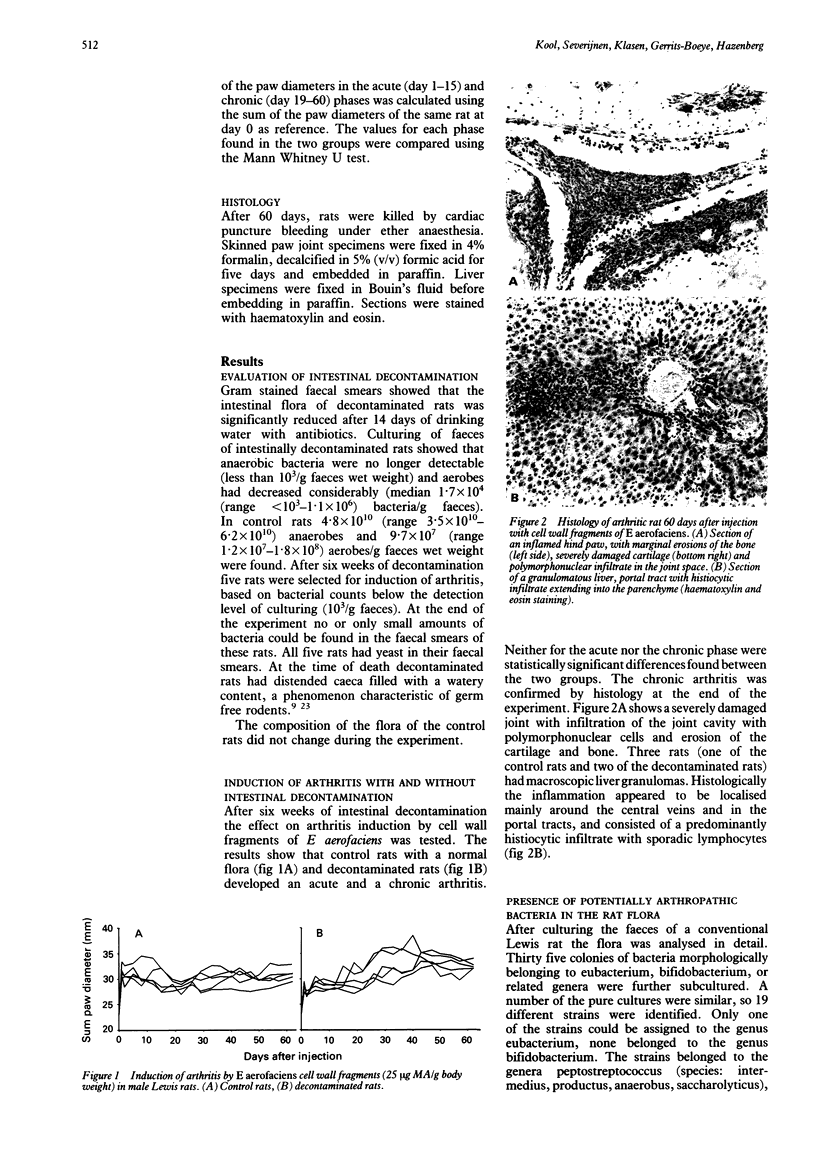
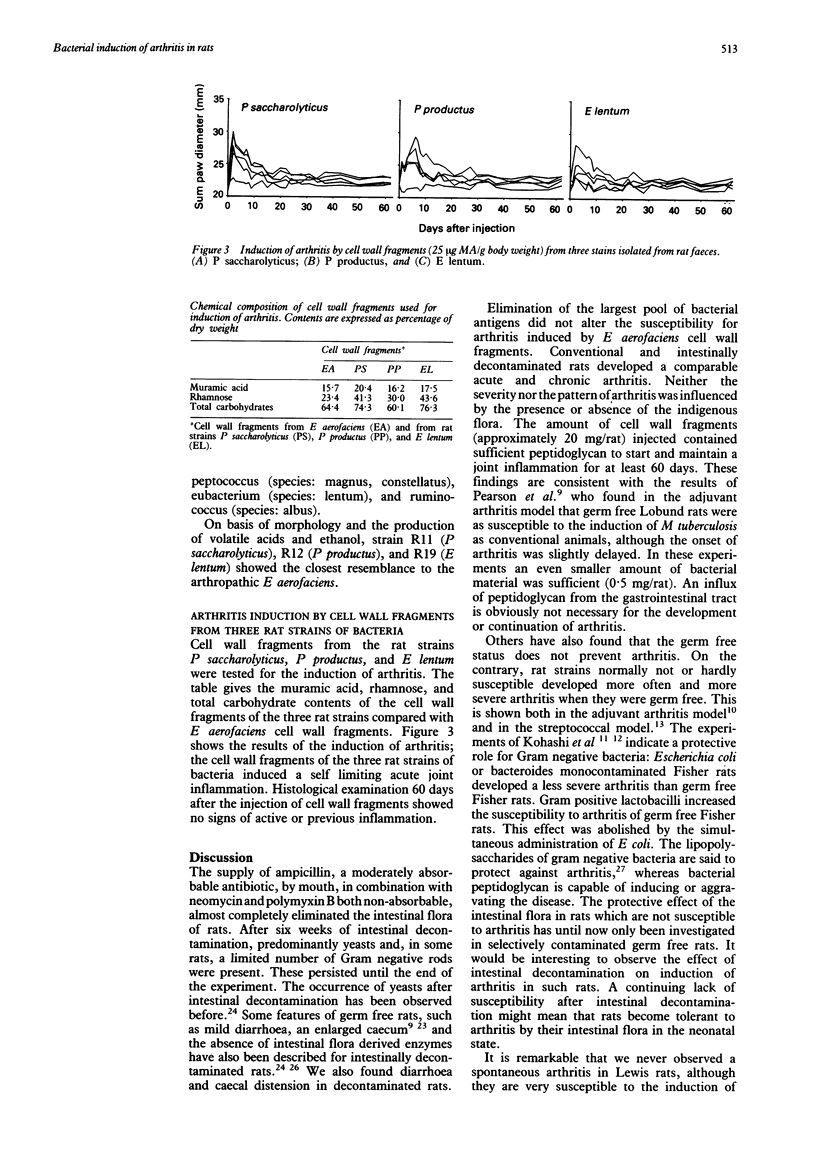
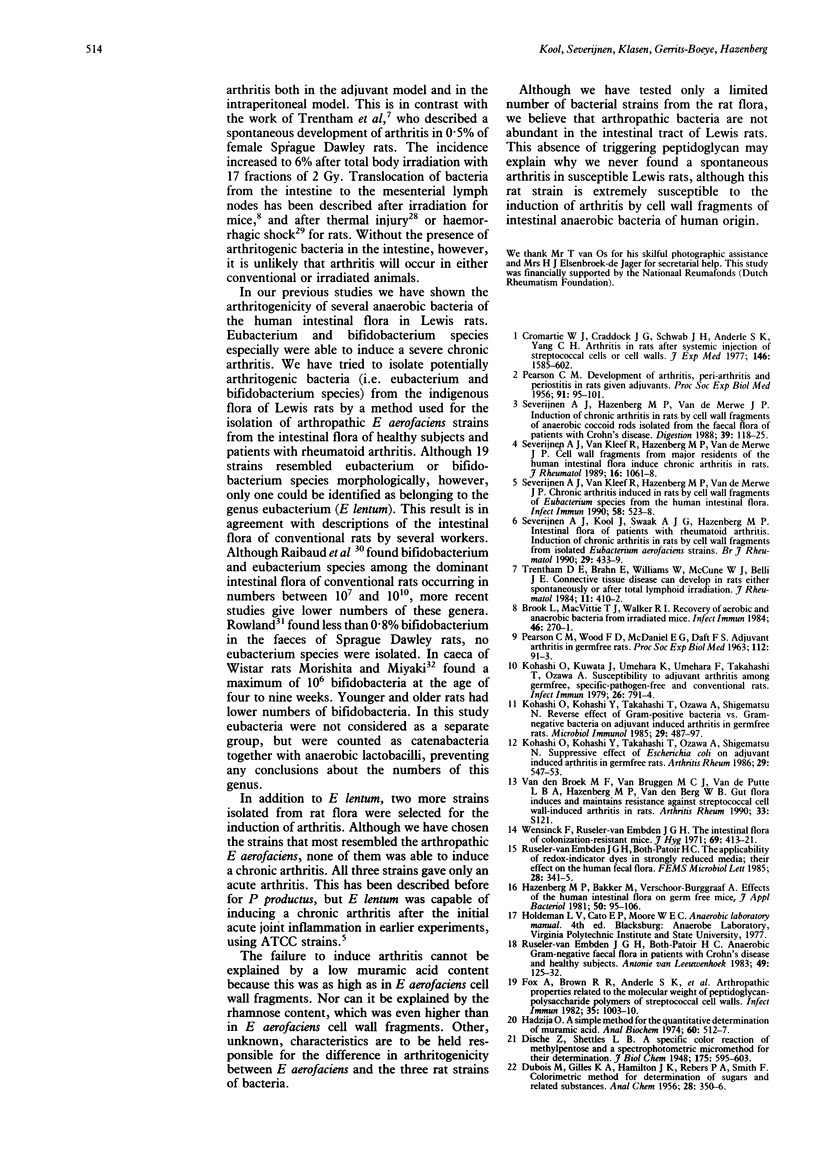
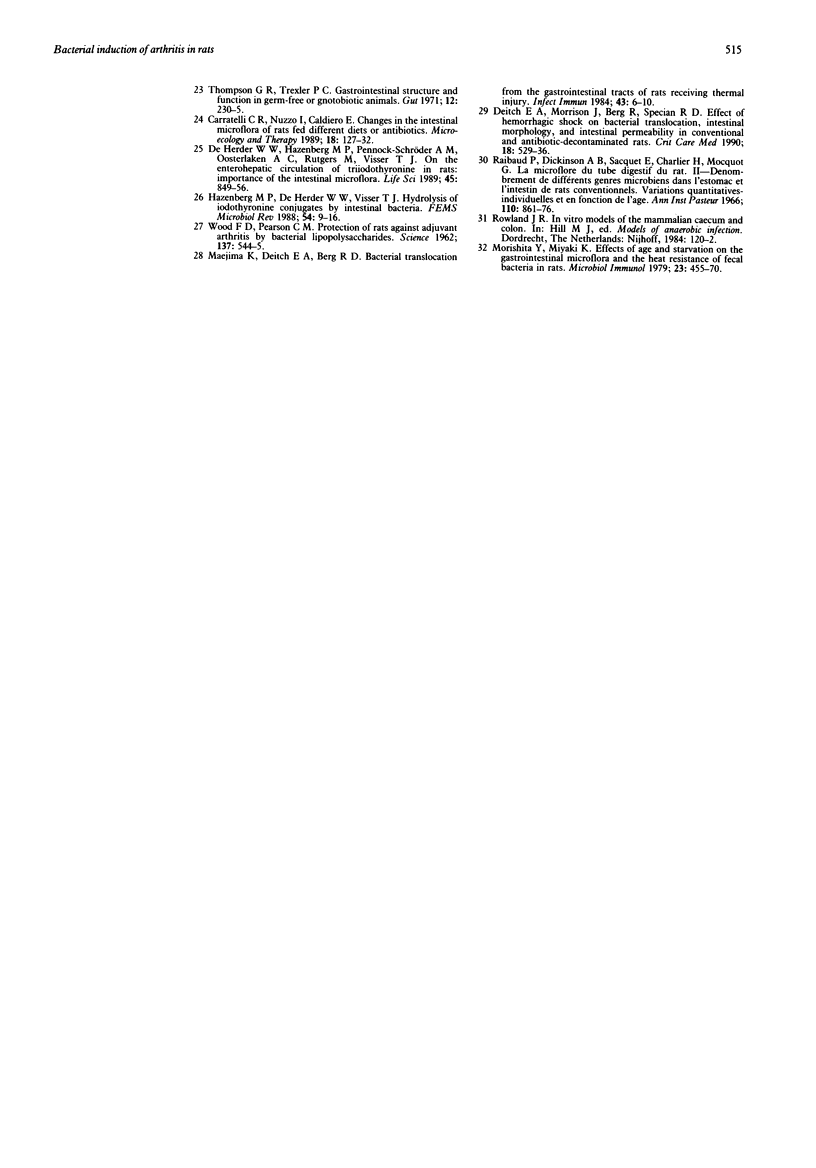
Images in this article
Selected References
These references are in PubMed. This may not be the complete list of references from this article.
- Brook I., MacVittie T. J., Walker R. I. Recovery of aerobic and anaerobic bacteria from irradiated mice. Infect Immun. 1984 Oct;46(1):270–271. doi: 10.1128/iai.46.1.270-271.1984. [DOI] [PMC free article] [PubMed] [Google Scholar]
- Cromartie W. J., Craddock J. G., Schwab J. H., Anderle S. K., Yang C. H. Arthritis in rats after systemic injection of streptococcal cells or cell walls. J Exp Med. 1977 Dec 1;146(6):1585–1602. doi: 10.1084/jem.146.6.1585. [DOI] [PMC free article] [PubMed] [Google Scholar]
- Deitch E. A., Morrison J., Berg R., Specian R. D. Effect of hemorrhagic shock on bacterial translocation, intestinal morphology, and intestinal permeability in conventional and antibiotic-decontaminated rats. Crit Care Med. 1990 May;18(5):529–536. doi: 10.1097/00003246-199005000-00014. [DOI] [PubMed] [Google Scholar]
- Fox A., Brown R. R., Anderle S. K., Chetty C., Cromartie W. J., Gooder H., Schwab J. H. Arthropathic properties related to the molecular weight of peptidoglycan-polysaccharide polymers of streptococcal cell walls. Infect Immun. 1982 Mar;35(3):1003–1010. doi: 10.1128/iai.35.3.1003-1010.1982. [DOI] [PMC free article] [PubMed] [Google Scholar]
- Hadzija O. A simple method for the quantitative determination of muramic acid. Anal Biochem. 1974 Aug;60(2):512–517. doi: 10.1016/0003-2697(74)90261-9. [DOI] [PubMed] [Google Scholar]
- Hazenberg M. P., Bakker M., Verschoor-Burggraaf A. Effects of the human intestinal flora on germ-free mice. J Appl Bacteriol. 1981 Feb;50(1):95–106. doi: 10.1111/j.1365-2672.1981.tb00874.x. [DOI] [PubMed] [Google Scholar]
- Hazenberg M. P., de Herder W. W., Visser T. J. Hydrolysis of iodothyronine conjugates by intestinal bacteria. FEMS Microbiol Rev. 1988 Feb;4(1):9–16. doi: 10.1111/j.1574-6968.1988.tb02709.x-i1. [DOI] [PubMed] [Google Scholar]
- Kohashi O., Kohashi Y., Takahashi T., Ozawa A., Shigematsu N. Reverse effect of gram-positive bacteria vs. gram-negative bacteria on adjuvant-induced arthritis in germfree rats. Microbiol Immunol. 1985;29(6):487–497. doi: 10.1111/j.1348-0421.1985.tb00851.x. [DOI] [PubMed] [Google Scholar]
- Kohashi O., Kohashi Y., Takahashi T., Ozawa A., Shigematsu N. Suppressive effect of Escherichia coli on adjuvant-induced arthritis in germ-free rats. Arthritis Rheum. 1986 Apr;29(4):547–553. doi: 10.1002/art.1780290413. [DOI] [PubMed] [Google Scholar]
- Kohashi O., Kuwata J., Umehara K., Uemura F., Takahashi T., Ozawa A. Susceptibility to adjuvant-induced arthritis among germfree, specific-pathogen-free, and conventional rats. Infect Immun. 1979 Dec;26(3):791–794. doi: 10.1128/iai.26.3.791-794.1979. [DOI] [PMC free article] [PubMed] [Google Scholar]
- Maejima K., Deitch E. A., Berg R. D. Bacterial translocation from the gastrointestinal tracts of rats receiving thermal injury. Infect Immun. 1984 Jan;43(1):6–10. doi: 10.1128/iai.43.1.6-10.1984. [DOI] [PMC free article] [PubMed] [Google Scholar]
- Morishita Y., Miyaki K. Effects of age and starvation on the gastrointestinal microflora and the heat resistance of fecal bacteria in rats. Microbiol Immunol. 1979;23(6):455–470. doi: 10.1111/j.1348-0421.1979.tb00485.x. [DOI] [PubMed] [Google Scholar]
- PEARSON C. M. Development of arthritis, periarthritis and periostitis in rats given adjuvants. Proc Soc Exp Biol Med. 1956 Jan;91(1):95–101. doi: 10.3181/00379727-91-22179. [DOI] [PubMed] [Google Scholar]
- PEARSON C. M., WOOD F. D., McDANIEL E. G., DAFT F. S. Adjuvant arthritis induced in germ-free rats. Proc Soc Exp Biol Med. 1963 Jan;112:91–93. doi: 10.3181/00379727-112-27959. [DOI] [PubMed] [Google Scholar]
- Raibaud P., Dickinson A. B., Sacquet E., Charlier H., Mocquot G. La microflore du tube digestif du rat. II. Dénombrement de différents genres microbiens dans l'estomac et l'intestin de rats conventionnels. Variation quantitiatives individuelles et en fonction de l'age. Ann Inst Pasteur (Paris) 1966 Jun;110(6):861–876. [PubMed] [Google Scholar]
- Ruseler-van Embden J. G., Both-Patoir H. C. Anaerobic gram-negative faecal flora in patients with Crohn's disease and healthy subjects. Antonie Van Leeuwenhoek. 1983 Jun;49(2):125–132. doi: 10.1007/BF00393670. [DOI] [PubMed] [Google Scholar]
- Severijnen A. J., Hazenberg M. P., van de Merwe J. P. Induction of chronic arthritis in rats by cell wall fragments of anaerobic coccoid rods isolated from the faecal flora of patients with Crohn's disease. Digestion. 1988;39(2):118–125. doi: 10.1159/000199614. [DOI] [PubMed] [Google Scholar]
- Severijnen A. J., van Kleef R., Hazenberg M. P., van de Merwe J. P. Cell wall fragments from major residents of the human intestinal flora induce chronic arthritis in rats. J Rheumatol. 1989 Aug;16(8):1061–1068. [PubMed] [Google Scholar]
- Severijnen A. J., van Kleef R., Hazenberg M. P., van de Merwe J. P. Chronic arthritis induced in rats by cell wall fragments of Eubacterium species from the human intestinal flora. Infect Immun. 1990 Feb;58(2):523–528. doi: 10.1128/iai.58.2.523-528.1990. [DOI] [PMC free article] [PubMed] [Google Scholar]
- Thompson G. R., Trexler P. C. Gastrointestinal structure and function in germ-free or gnotobiotic animals. Gut. 1971 Mar;12(3):230–235. doi: 10.1136/gut.12.3.230. [DOI] [PMC free article] [PubMed] [Google Scholar]
- Trentham D. E., Brahn E., Williams W., McCune W. J., Belli J. E. Connective tissue disease can develop in rats either spontaneously or after total lymphoid irradiation. J Rheumatol. 1984 Jun;11(3):410–412. [PubMed] [Google Scholar]
- WOOD F. D., PEARSON C. M. Protection of rats against adjuvant arthritis by bacterial lipoplysaccharides. Science. 1962 Aug 17;137(3529):544–545. doi: 10.1126/science.137.3529.544. [DOI] [PubMed] [Google Scholar]
- Wensinck F., Ruseler-van Embden J. G. The intestinal flora of colonization-resistant mice. J Hyg (Lond) 1971 Sep;69(3):413–421. doi: 10.1017/s0022172400021665. [DOI] [PMC free article] [PubMed] [Google Scholar]
- de Herder W. W., Hazenberg M. P., Pennock-Schröder A. M., Oosterlaken A. C., Rutgers M., Visser T. J. On the enterohepatic cycle of triiodothyronine in rats; importance of the intestinal microflora. Life Sci. 1989;45(9):849–856. doi: 10.1016/0024-3205(89)90179-3. [DOI] [PubMed] [Google Scholar]



